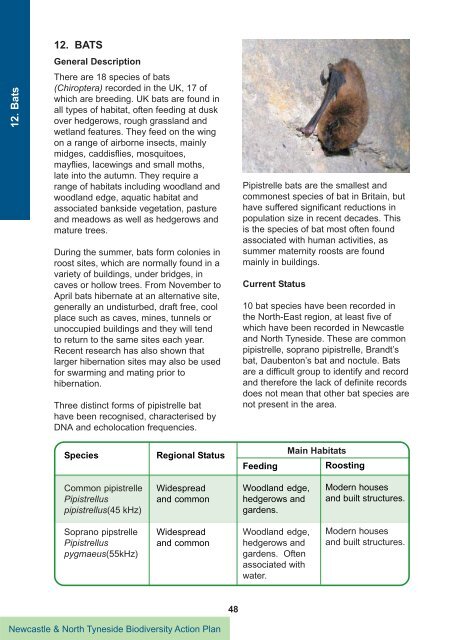III. Species Action Plans - Newcastle City Council
III. Species Action Plans - Newcastle City Council
III. Species Action Plans - Newcastle City Council
You also want an ePaper? Increase the reach of your titles
YUMPU automatically turns print PDFs into web optimized ePapers that Google loves.
12. Bats<br />
12. BATS<br />
General Description<br />
There are 18 species of bats<br />
(Chiroptera) recorded in the UK, 17 of<br />
which are breeding. UK bats are found in<br />
all types of habitat, often feeding at dusk<br />
over hedgerows, rough grassland and<br />
wetland features. They feed on the wing<br />
on a range of airborne insects, mainly<br />
midges, caddisflies, mosquitoes,<br />
mayflies, lacewings and small moths,<br />
late into the autumn. They require a<br />
range of habitats including woodland and<br />
woodland edge, aquatic habitat and<br />
associated bankside vegetation, pasture<br />
and meadows as well as hedgerows and<br />
mature trees.<br />
During the summer, bats form colonies in<br />
roost sites, which are normally found in a<br />
variety of buildings, under bridges, in<br />
caves or hollow trees. From November to<br />
April bats hibernate at an alternative site,<br />
generally an undisturbed, draft free, cool<br />
place such as caves, mines, tunnels or<br />
unoccupied buildings and they will tend<br />
to return to the same sites each year.<br />
Recent research has also shown that<br />
larger hibernation sites may also be used<br />
for swarming and mating prior to<br />
hibernation.<br />
Three distinct forms of pipistrelle bat<br />
have been recognised, characterised by<br />
DNA and echolocation frequencies.<br />
<strong>Species</strong><br />
Common pipistrelle<br />
Pipistrellus<br />
pipistrellus(45 kHz)<br />
Soprano pipstrelle<br />
Pipistrellus<br />
pygmaeus(55kHz)<br />
Regional Status<br />
Widespread<br />
and common<br />
Widespread<br />
and common<br />
<strong>Newcastle</strong> & North Tyneside Biodiversity <strong>Action</strong> Plan<br />
48<br />
Pipistrelle bats are the smallest and<br />
commonest species of bat in Britain, but<br />
have suffered significant reductions in<br />
population size in recent decades. This<br />
is the species of bat most often found<br />
associated with human activities, as<br />
summer maternity roosts are found<br />
mainly in buildings.<br />
Current Status<br />
10 bat species have been recorded in<br />
the North-East region, at least five of<br />
which have been recorded in <strong>Newcastle</strong><br />
and North Tyneside. These are common<br />
pipistrelle, soprano pipistrelle, Brandt’s<br />
bat, Daubenton’s bat and noctule. Bats<br />
are a difficult group to identify and record<br />
and therefore the lack of definite records<br />
does not mean that other bat species are<br />
not present in the area.<br />
Feeding<br />
Woodland edge,<br />
hedgerows and<br />
gardens.<br />
Woodland edge,<br />
hedgerows and<br />
gardens. Often<br />
associated with<br />
water.<br />
Main Habitats<br />
Roosting<br />
Modern houses<br />
and built structures.<br />
Modern houses<br />
and built structures.

















